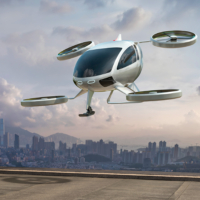
Key differences between Orin and Xavier
The Jetson AGX Orin modules deliver an AI performance that can reach 275 TOPS with up to 64 GB of memory, compared to 30 TOPS with up to 32 GB of memory for Jetson Xavier. Power consumption of the Jetson Orin modules has also been optimised like never before, offering a maximum consumption of 60 W compared to a maximum of 40 W with Jetson Xavier.
This makes it the world’s most powerful AI computer for autonomous machines, without compromising on low, ultra-optimised consumption.
It performs up to 8 times better than the Jetson Xavier range for simultaneously handling a larger number of pipelines. Interface support is also optimised with multiple sensors, better satisfying recent trends in the field of next-generation embedded robotics.
Networking, which in Jetson Xavier was possible only with conventional Ethernet, can now be achieved with Gigabit Ethernet in Jetson Orin. This makes data transmission much faster than before.
NVDIA Ampere GPU: 3rd Generation Tensor Cores, Sparsity, Streaming Multiprocessor
Jetson AGX Orin contains an integrated Ampere GPU that provides a total of 2048 CUDA cores and 64 Tensor cores with up to 131 Sparse TOPs of INT8 Tensor compute and up to 4.096 FP32 TFLOPs of CUDA compute. It’s New Tensor Float 32 (TF32) precision provides up to 5X the training throughput over the previous generation to accelerate AI and data science model training without requiring any code changes.
The GPU also brings support for sparsity, a fine-grained compute structure that doubles throughput and reduces memory usage. This New Sparsity feature can take advantage of fine-grained structured sparsity in deep learning networks to double the throughput of Tensor Core operations over the prior generation Turing Tensor Cores.
The NVIDIA Ampere GPU along with supporting 3rd generation tensor cores and TensorRT cores, introduces a new design for the Streaming Multiprocessor (SM) that can improve performance per watt and performance per area. Ampere GPUs improve on the previous NVIDIA Turing generation; and are software compatible so that the same APIs are used.

CPU: 1.7x the performance in advance
The biggest change in the CPU in Jetson AGX Orin is replacing the NVIDIA Carmel CPU clusters with the Arm Cortex-A78AE. The Jetson AGX Orin CPU is made up of 12 CPU Cores, enabling 1.7x the performance compared to the 8-core NVIDIA Carmel CPU on Jetson AGX Xavier, with each core consisting of a 64KB Instruction L1 Cache and 64KB Data Cache along with a 256 KB of L2 Cache. Each cluster consists of 2MB L3 Cache, just as the Jetson AGX Xavier and the maximum frequency supported on the CPU is 2 GHz.

Memory & Storage: 1.4x the memory bandwidth and 2x the storage of the Jetson AGX Xavier
In comparison, the NVIDIA Jetson AGX Orin brings support for 1.4x the memory bandwidth and 2x the storage of the NVIDIA Jetson AGX Xavier, enabling 32 GB of 256-bit LPDDR5 and 64 GB of eMMC. The DRAM supports a maximum clock speed of 3200 MHz, with 6400 Gbps per pin, enabling 204.8 GB/s of memory bandwidth.

Multi-Standard Video Encoder & Decoder and a JPEG processing block (NVJPEG)
The NVIDIA Jetson AGX Orin contains a Multi-Standard Video Encoder (NVENC), a Multi-Standard Video Decoder (NVDEC) and a JPEG processing block (NVJPEG) with the NVENC enabling full hardware acceleration for various encoding standards including H.265, H.264 and AV1.
The NVDEC enables full hardware acceleration for various decoding standards including H.265, H.264, AV1, VP9 with the NVJPG responsible for JPEG (de)compression calculations (based on the JPEG still image standard), image scaling, decoding (YUV420, YUV422H/V, YUV444, YUV400) and colour space conversion (RGB to YUV).
Next-generation Vision Accelerator Engine: PVA v2.
The PVA enables support for various computer vision kernels such as filtering, warping, image pyramid, feature detection and FFT, which is essential for computer vision applications on the detector, tracker, object tracker, stereo disparity, and visual perception.
The NVIDIA Jetson AGX Orin is ready to be embedded into next-gen autonomous machines, robotics or drones working for retail, manufacturing, transportation, agtech, smart city, aerospace, etc.
Conclusion
The NVIDIA Jetson AGX Xavier and NVIDIA Jetson AGX Orin match in physical size, with both being in the same price range but the NVIDIA Jetson AGX Orin has much more power. Even with Early Access software, the aforementioned benchmarks demonstrate that the Orin is an incredibly promising new addition to the Jetson family and we can expect even better results in the near future with software updates.
By releasing NVIDIA Jetson AGX Orin, NVIDIA indisputably made the world of embedded AI take a large step forward. Jetson Xavier devices are already incredibly powerful and full of potential, but with Orin now paving the way forward for the continuing growth of embedded AI, planning and work on bigger and more complex projects that previously, could not even have been dreamt about.
For those who were limited by the number of tasks, NVIDIA has now pushed the bar higher. In fact, we here at Assured Systems as a major leap forward in terms of Edge AI applications and very much a game-changer.










